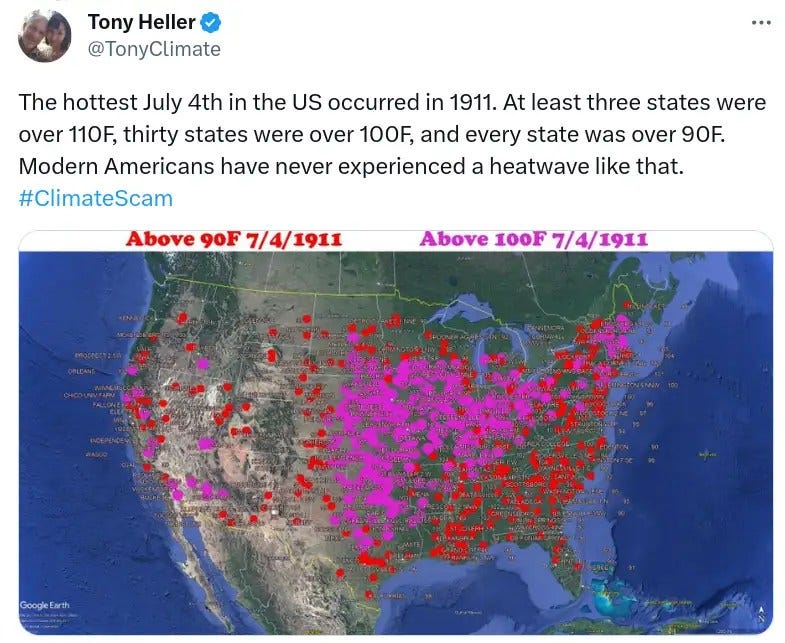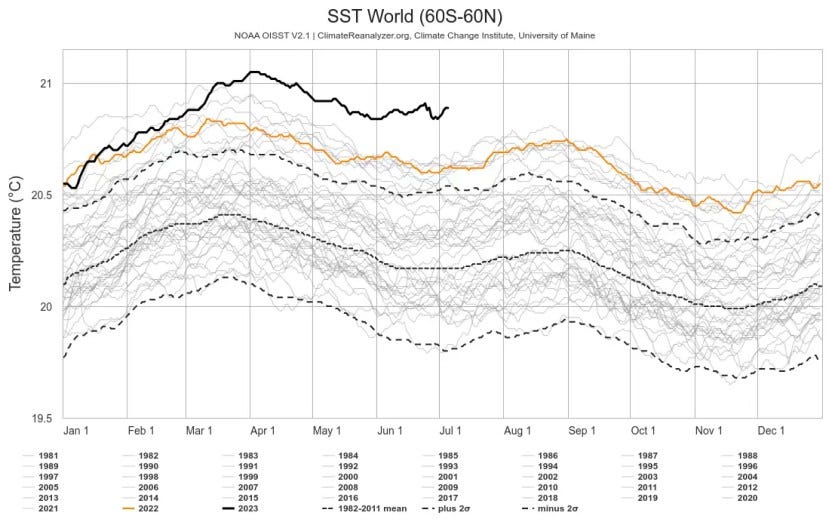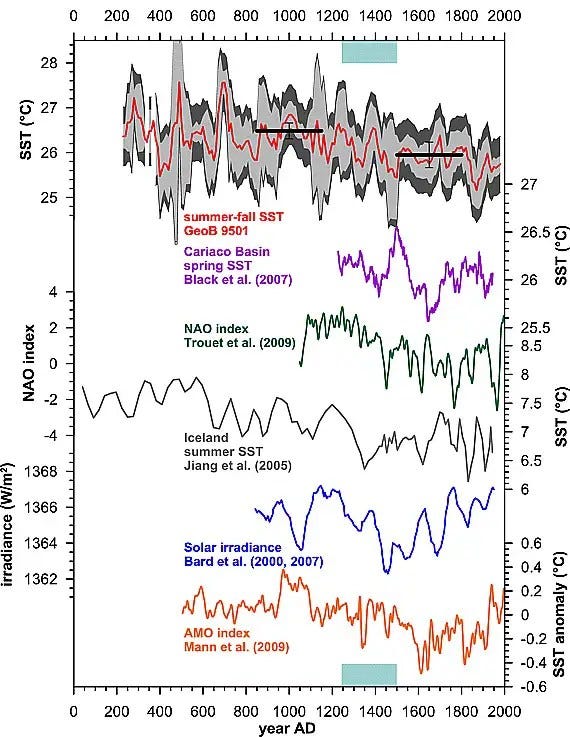Thucydides in The Peloponnesian War speaks of Athenian prisoners dying from “variation in the temperature” in the conditions they were kept. Athens itself suffered deadly droughts at least in the late Eighth Century, before Christ, and in the Fourth Century, BC, too.
Plutarch speaks of the nasty effects of drought in Egypt. There are also certain Biblical hints of poor weather in that land.
And we all remember the backstory for this Woodhouse quip: “Mike nodded. A somber nod. The nod Napoleon might have given if somebody had met him in 1812, and said, ‘So you’re back from Moscow, eh?'”
These, from memory, are only a wee hatful of only-the-Lord-knows how many examples—the unknown number being our point. Still, it is a large enough sample to conclude that weather varies, and not always in pleasant ways. Though pleasant is relative. Mongols (with Spaniards) and Japanese have different views of the pleasantness of wind, for instance.
Last week there was a heat wave—of hot propaganda. Many boasted it was the hottest day evah. The record was broke by a hundredth of a degree, or maybe it was two hundredths. The glee behind these claims was unmistakable. But global warming has its own version of Steve Sailer in Tony Heller, who was quick to point out this picture (see also this):
Heller used old temperature readings, made by thermometers. The ones that aren’t deleted, that is. There is also a different set of contemporary thermometers that was 5 degrees cooler. The propagandists relied on output from Expert models, which goes through all manner of massagings before becoming “the temperature”. Which isn’t to say it’s wrong, only that it might be, and that when you see these numbers they should always have a predictive (and not parametric) plus-or-minus attached to them. We don’t here have to understand that difference. But we must always insist on knowing the model’s uncertainty.
Incidentally, Big Joe Bastardi (who is still entering lifting contests) tweeted Thursday: “the summer so far features the 2cnd coolest June max temp wise since 2000 and the last. 45 days more than 60% of nation BELOW NORMAL.” That’s a model, too. But a different one, so models can differ.
Now suppose this year you inaugurate the world’s first ever Journalist Marathon. The reporter with the most number of stories in a month which contains no lies or logical omissions wins. Somebody will win. Well, maybe. Anyway, if one did win, that win will break the “record”. Or, rather, it will set it. In Year Two, there’s a good chance that record set in Year One will be broken again, simply because besting one number is not that hard.
Shorter series see more records broken than longer ones, ceteris paribus. With me?
Satellites have been lofting away for about 45 short years. Humans have been roaming around for millennia. It’s easy to break a record of only 45 years, and hard to break one of thousands. It’s especially easy to break a modeled record, which is what the satellite record is: model output. You didn’t think satellites were lowering thermometers through the atmosphere, did you?
That means it’s always a disservice to spit out month-by-month pictures without the plus-or-minuses. It’s worse than that, too, because these models purport to be something called a globally average temperature. Which might have its uses, but is a thing no one or nothing experiences.
Here’s an example of a panic picture that was making the rounds last week (from this official source):
Scary!
But this is only 43 years of data: and they got lucky that the mean used to draw the dashed line in the middle used the coldest years. The two hotter years were 2015 and 2016, depending on which month you look at. And then we read the fine print (at bottom):
… [the] gridded dataset that provides estimates of temperature based on a blend of satellite, ship, and buoy observations.
A blend. What a nice word.
It’s as I said: these lines are models. Models which are not constant through time, either. So where are the predictive + and -? They must be there to make any decisions. After all these one-number points in time are meant to represent the temperature of all the world’s oceans (or most of them).
What was the temperature of the oceans in 1001? How could you know to any actionable degree of uncertainty? Here’s one guess:
That’s from this paper. Notice the + and -, and notice, too, that suddenly 2023 doesn’t look at interesting.
Again, tell me, what was the temperature in Rome on 15 March 44 BC? “Rome” is not specific. Rome is, and was, big, so the temperature varies where you are. So let’s pick the Theatre of Pompey. What was the noontime temp that day?
Nobody knows. So if you compare that day to to-day, what you can say? Well, nothing certain. You can measure the temperature today, and you guess the temperature then. But your guess is model dependent—and you can never check it.
It used to be said that Rome was warmer back then than now. But that claim, somehow, became an uncomfortable, and it’s being pulled back bit by bit. It’s not a bad bet to say that Experts will soon say Rome was freezing most Marchs.
So. If you want to say a record has been broken, even using the propaganda phrase “since records have been kept”, you can’t make it. Not with reasonable certainty.
Subscribe or donate to support this site and its wholly independent host using credit card click here. Or use the paid subscription at Substack. Cash App: $WilliamMBriggs. For Zelle, use my email: matt@wmbriggs.com, and please include yours so I know who to thank.







💬 “Climate change” will simultaneously cause every beast and bug and weed which is a menace to flourish, and it will corrupt or kill every furry, delicious, and photogenic animal.
↑↑ Briggs' winner quote my all-times favourite 😊
How would we know if the temperature went up? The only decent data collection is in the continental US and as Anthony Watts proved fifteen years ago it has serious issues. The models use a single point thermometer to provide temp data for I think the number was 1200 km in some locations, where thermometer coverage is sparse.
But even assuming that we knew the temperature all over the earth at say 5 ft off the ground, just as a sorta common thermometer height, or say 1000 ft above MSL neither of those represent a significant amount of the thermal energy available at the earth's surface, most of which is gonna come from the ground or the liquid water, because they have a specific heat that is several times higher gram for gram and a density that is many times higher at the same temperature they have an order of magnitude more thermal energy so any change in air temperature should be expected to be dragged right back to equilibrium. What I am trying to say is that air temperature is not likely to ever be the driver of climate change, certainly a change of 1 degree C should not be expected to change anything.
But even if it could we come to the problem that another commenter pointed out, how do we sort out beneficial from harmful effects. The media view of climate change really only makes sense on the supposition that it is an infernal miracle, an ill wind that blows no good to anybody simply doesn't exist in nature.